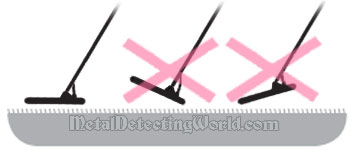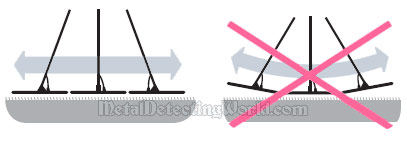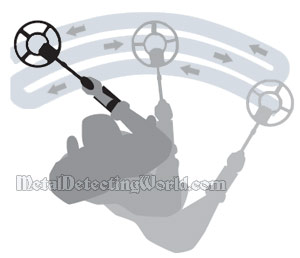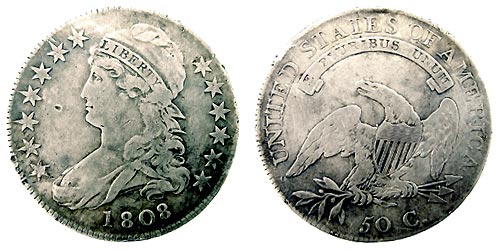How To Metal Detect, page 2
Metal Detecting Tips: Search Coil Discipline, Gridding, Effective Area Coverage, 'Plug-Splitting' Technique and 'Coil-Heel Pinpointing' Method
There are as many techniques and methods for metal detecting and treasure hunting as they are active people in this hobby! Here are some basic recommendations for metal detecting on land:
Search Coil Discipline
1) Make sure that the angle of the coil is properly adjusted: the coil is parallel to the ground when touching the surface.

You can read more details on my Search Coil Discipline In Details page.
2) Keep the search coil parallel to the ground surface at a constant height to eliminate false signals. Sweeping the search coil in a slight semicircular pattern will maintain a more parallel relationship between the ground surface and the search coil.
3) Keep the search coil as close to the ground as possible to maintain maximum operational depth range.
When searching uneven ground, keep an even search coil height above the obstacles and increase sensitivity if possible.
You can get more details on my Keeping Search Coil Parallel and Close to Ground page.
4) Do not swing the coil in a pendulum motion so that it arcs upward at the end of a sweep - depth will be lost at these points.

You can get more details on my No Pendulum Swinging page.
5) Overlap the sweeps by advancing the search coil as much as 25% of the coil diameter, especially if Concentric, Monoloop, or Coaxial coil configurations are used.

You can get more details on my Search Coil Sweep Overlapping page.
6) Sweep the search coil slowly and methodically. Do not try to cover an acre in 10 minutes!
NOTE: Some metal detectors require fast movements of a search coil for achieving maximum detecting range. Please consult the instruction manual for your metal detector.
7) Do not bang the search coil against solid objects such as tree roots, large rocks, walls, etc.
You can get more details on my Methodical and Careful Search Coil Swinging page.
To be familiar with all types of modern search coils, their designs, characteristics, abilities (depending on type and size), advantages and disadvantages, to learn basic search coil tricks, and also to read about hermetic sealing of coil covers against dirt and moisture, please visit my "Truth About Search Coils" section.
Area Coverage and Gridding
1) Gridding refers to rigid and disciplined search routes along predetermined boundaries used to thoroughly cover a hunt site in several directions. This method can be very effective in areas free from obstructions such as farm fields, meadows, large lawns and parks. You can lay an area out by artificial means with ropes, golf tees, cones, etc. To detect good targets that you might have missed during your first search, rework a hunt site at angles perpendicular and oblique to the original search patterns or gridding patterns. This also help encounter good targets with less interference from previously rejected targets.
If you do not have any artificial means to lay out the area, use imaginary boundary lines that can be determined by either natural or cultural land marks such as the church spire, tower, smoke stack, etc. For example, when searching a farm field without any cultural land marks around, I pick out tall trees standing opposite to each other at the opposite sides of the field to designate my search paths. If I can see my tracks on a return pass, I try to walk and detect parallel to them and overlap the ground I have previously covered.
If you metal detect in natural wooded areas with rough terrain, gridding an area out can be unpractical and time consuming. In such areas, again, you can set boundaries in your mind related to natural objects or land marks. Pick out large stones, apple trees, stone walls, a well, a corner of an old foundation, or other obvious references. Work within these boundaries first before trying other areas.
When using imaginary boundary lines, drag your foot occasionally to mark the dirt or fallen leaves to show where you have been. On a return pass, scan next to these drag marks as you would scan next to a rope or string. If you come to an obstacle, work carefully around or through it and proceed back on course.
2) At the site that has been searched consistently by others in the past, try to think what they might have done and do just the opposite. Thoroughly search the areas with or near obstacles such as metal pipes (with a smaller search coil and reduced sensitivity), bushes, logs (move them), tall grass (flatten it) and fences.
You can find more detailed info on the search methods and strategy in regard to the abandoned sites of former homesteads in my article - How To Metal Detect Around Cellar Holes Successfully.
3) Set short term goals on smaller areas which are directed by logic and/or intuition. If a hunt site defies logic in choosing a likely place to start, spend some time randomly searching for areas of concentrated signals - a "hot pocket." When you locate it, leave other spots until this one is searched slowly and deliberately.
When you arrive at the hunt site that had been searched, try to spot visually the patch with a "cluster" of dug holes (or their traces) - the cluster spot which was initially a "hot" spot, and scan every inch of the ground in between the holes. In 99.9% cases, this approach turns out to be very rewarding.
If you arrive at the hunt site with a group of buddies, and one of them hits the hot spot, make sure you search that spot right after your buddy leaves it. Though, in most cases, the rest of the group is immediately invited to search the hot spot along with its finder.
4) Do not leave the hunt site without knowing that you gave it at least a 120% effort.
5) Revisit the hunt sites. Over the winter, the ground freezes and thaws causing many targets to shift position and become detectable. The roots, moles and woodchucks can also affect the position and depth of a coin by their actions.
Miscellaneous Tips
1) Coins lying in the ground at an angle may be missed on one search coil pass but detected when the search coil approaches from a different angle. Approach the target from different angles until you get the best signal.
2) If you get a questionable signal, dig it! Some broken signals are emitted by the good targets which are positioned in close proximity to iron targets, therefore, partially masked by them.
This 1808 Capped Bust Half Dollar Was Partially Masked by a Large Square Nail

3) If the location produces numerous meter readings from "pull-tab" to "silver," chances are, little or no detecting has been done here - it is a "virgin" site! A high concentration of meter readings from "iron" to "pull-tab" would be indicating that the site had been detected with discrimination set to reject pull-tabs, and therefore most gold rings, gold chains and nickels were left undetected.
4) Plug-Splitting Technique:
While recovering the target, cut the dirt plug out and break it in two halves. Place the coil beside you and pass each half ABOVE the coil - electromagnetic field above the coil is the same as it is under the coil (except the coaxial coils). After you received a signal from one half, split it in two pices again and pass each half above the coil. Repeat these steps until you have a small amount of dirt including a target in your hand.
Scanning the dirt lump by moving it above the search coil

This simple Plug-Splitting technique will help you recover the targets faster. Just make sure you do not wear rings, bracelets or a watch which will produce a signal when you pass your hand with dirt in front of the coil.
5) 'Coil-Heel Pinpointing' Technique:
If you do not have an electronic pinpointer yet, but you do not want to spend too much time looking for each target in a pile of dirt pulled out from the target hole, this simple but effective method will help you keep a fast pace of the target-detection/target-recovery process. This method is often implemented even when an electronic pinpointer is available.
After you remove all loose dirt containing the target from the hole, level off the dirt pile in a thin layer on the ground surface. Adjust a search coil in such a way that the coil's plane is at the right angle to the attached lower shaft. Then hold the shaft as shown on a picture below and move the coil over the spot and close to the surface while scanning the dirt with just the coil's heel area approaching the spot from different angles. You can operate your detector in either the Pinpoint mode or Discriminate mode during this procedure.

If you have to pile up the excavated dirt on a ground cloth of a limited size, you can simply scan the dirt pile, and this technique will work just fine. You can also use this technique to localize targets in the dirt-plugs that are hard to break apart. After the target's precise location in the plug is determined, you can safely cut the inseverable plug with a shovel or a knife to retrieve the target without damaging it.
All traditional methods of pinpointing coins using the detector's Pinpoint mode are described in the 'Search Coils' section, starting on this page: Search Coil Swinging Techniques.